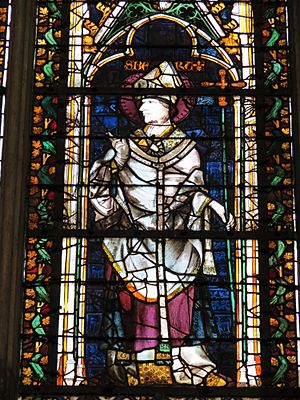Ansbert facts for kids
Quick facts for kids Saint Ansbert of Rouen |
|
|---|---|

Portrait of Ansbert in stained glass at Rouen Cathedral
|
|
| Born | Chaussy-sur-Epte |
| Died | c. 695 Hautmont |
| Venerated in | Roman Catholic Church |
| Canonized | Pre-Congregation |
| Feast | 9 February |
Ansbert (who died around 695 AD) was a very important person in the early history of France. He was a Frankish monk, an abbot (leader of a monastery), and later became a bishop in a city called Rouen. Today, he is known as a saint in the Catholic Church. He is sometimes called Ansbert of Chaussy, after his birthplace.
Ansbert's Early Life
Ansbert was born in a village called Chaussy-sur-Epte, which is in a historical area of Normandy known as the Vexin. He came from a noble family, meaning his family was important and had a high social standing. He received a very good education.
Ansbert had a successful career in government. He worked for the Merovingian king, Clotaire III. He was a senior member of the king's court. This means he was one of the king's top advisors and officials. He held important titles like chancellor and referendary. These roles involved managing royal documents and legal matters.
Ansbert was supposed to marry another future saint, Angadrisma. Her father, who also worked for King Clotaire, had arranged the marriage. However, Angadrisma wanted to become a nun. Stories say she became very ill, and this illness only went away when she joined a convent. This allowed her to follow her religious path. Some sources say Ansbert later married someone else.
Becoming a Religious Leader
In 673 AD, the same year King Clotaire III died, Ansbert decided to leave his government job. He chose to become a monk in the Benedictine order. Six years later, in 679 AD, he became the abbot of his monastery. This monastery was the famous Fontenelle Abbey.
Ansbert followed two other saints as abbot: Wandrille, who founded the abbey, and Lambert, who left to become a bishop. Under Ansbert's leadership, Fontenelle Abbey grew and became very successful. He greatly expanded and improved the abbey's library. He also set up local hospitals to help poor people.
While he was an abbot, Ansbert also served as a confessor to King Theodoric III. This meant he was a spiritual advisor to the king.
After several years, Ansbert was chosen to be the archbishop of Rouen. This happened after the previous archbishop, Saint Ouen, died around 683 or 684 AD. His former mentor, Saint Lambert, performed the ceremony to make him a bishop. Ansbert was then replaced as abbot at Fontenelle by Hildebert, who is also considered a saint.
Exile and Death
Even though Ansbert held a high position and had a good reputation, he was removed from his role as archbishop around 690 AD. A powerful official in the Frankish court, Pepin of Heristal, arranged for his dismissal. This happened because of what was called "a false accusation."
Historians believe Pepin might have done this because Ansbert opposed him politically. Or, perhaps Ansbert's very strict and serious way of life was not popular. He was sent away to a monastery in Hautmont. He stayed there until he died, sometime between 692 and 695 AD. It seems Pepin later changed his mind and agreed to let Ansbert return. However, Ansbert either died before he could travel back, or Pepin changed his mind again.
Ansbert's Legacy
A writer from the 12th century, Ordericus Vitalis, shared a story. It was said that Ansbert's remains (his bones) were disturbed by soldiers. However, Ordericus Vitalis believed these bones belonged to a different person named Ansbert. He said that Saint Ansbert's bones were still safe at Fontenelle Abbey when he was writing.
Another author from the 18th century, Alban Butler, stated that Ansbert's remains were later moved to St. Peter's Abbey in Ghent. Sadly, they were destroyed there by Calvinists in 1578.
Many saints are connected to Fontenelle Abbey. They are all remembered together on March 1st. Saint Ansbert's own special day of remembrance, his annual feast day, is February 9th.
See also
 In Spanish: Ansberto de Ruan para niños
In Spanish: Ansberto de Ruan para niños

